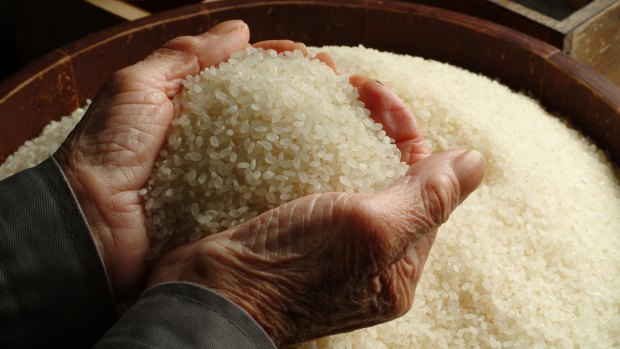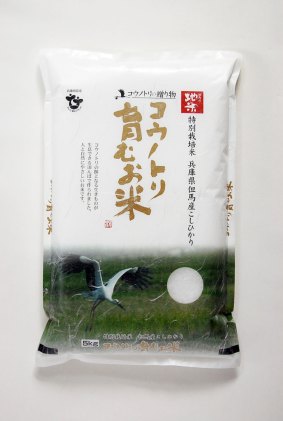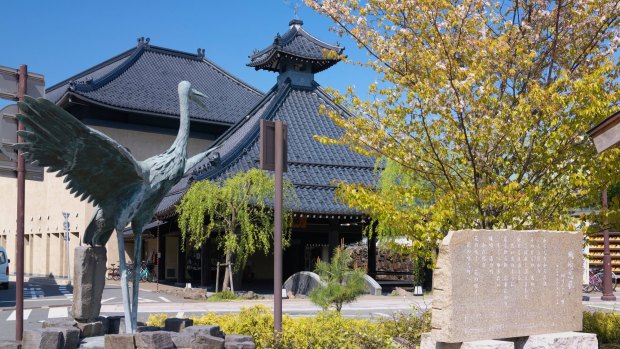This was published 6 years ago
How a rice dish is helping to save Japan's endangered storks
By Anthony Dennis

Stork rice.
One my favourite dishes in all of my travels around Asia is Singapore's classic chicken rice, a simple and simply beautiful dish of succulent steamed white meat sliced into bite-size pieces and served on fragrant rice with a side bowl of light soy sauce. But, here I am elsewhere in Asia, far removed from that tropical island state, in a place called Toyooka, Japan. It's a roughly 2½-hour train ride north-west of Kyoto where the prospect of eating something called "stork rice" is a somehow less appetising prospect.
Chicken rice is one thing while stork rice is surely something else entirely. But, as it eventuates, like nearly everything in this wonderfully enigmatic land, there's much more to it. Reassuringly, stork rice contains no traces of actual stork meat. In reality it's organic rice produced with a noble purpose of underwriting a clever and determined conservation program which rescued the magnificent oriental white stork from extinction in the wild in the 1970s.
Importantly, a portion of the proceeds from the sale of the rice are donated to assist the stork conservation effort. Because rice cultivated with the assistance of chemicals and pesticides can poison and even kill the storks that eat the crop, local authorities have encouraged and incentivised local rice-farmers to adopt organic farming methods. The organic stork rice grown in Hyogo, a prefecture on the main island of Honshu abutting the Sea of Japan of which Toyooka is part, has become popular among Japanese consumers, and is exported to markets such as the US and Singapore. Japanese revere this universal staple, whether it's organic or not, with a near religious fervour and they're willing to pay a premium for it.

Stork rice.
Yet some farmers in Hyogo resist growing their crops organically. The result? While many storks have been saved, the species remains under threat. Fortunately, as one of my guides in Toyooka points out, modern pesticides are not quite as lethal as those in the past but the potential to harm the birds still exists.
After having just arrived in Toyooka, it's already time to spot the surely-not-succulent bird I naively and momentarily imagined I may have to eat when the concept of stork rice was first mentioned to me. One of the easiest locations for spotting the birds is in a rice-field next to the town's oriental stork tourist centre.
It's not long before I see my first oriental white stork with its unmistakable and majestic two-metre wing span and a prominent beak of 25 centimetres in length, soaring above the lime-green fields. The rice-field is punctuated by tall, telegraph-like poles with platforms built atop, large enough for storks to construct and maintain their nests, staggeringly huge and sturdy to contain their wing-spans.

Hot spring of Kinosaki, Toyooka.Credit: Alamy
Today, or at least as of July this year, there are an estimated 103 storks in the wild and 95 captive in Toyooka. You can sample stork rice at the touristy "eco-museum centre" which is close to where captive storks can be observed being fed and raised at certain times of the day. But I elect to head into town where the rice is served at a rustic local seafood restaurant, Kaisen Umaimonya Wahei, specialising in snow crab, a delicacy in these parts.
I sit (make that squat) down to lunch, the sole caucasian in attendance, and tuck into what my guides assure me is authentic stork rice. I find it difficult to discern any difference between it and the ordinary variety I've grown accustomed to on my numerous previous visits to Japan. Japanese rice, after all, is invariably delicious and of a superior quality that the country's consumers actively demand.
Yet with every single grain I swallow there's the satisfaction of knowing that this rice benefits the oriental white stork and the communities in which it lives. However, the commercial imperatives and benefits of helping to preserve the oriental white stork are only part of its story.
The bird is credited with having centuries ago discovered the therapeutic hot springs for which the area is famous. Legend dictates that in Kinosaki, a famous neighbouring onsen, or hot springs, town, that a Shinto Buddhist priest came across stork with a badly wounded leg that had been healed when it dipped its appendage in the restorative hot spring waters. Today, there are statues of the oriental white stork at the entrance of the oldest onsen Kouno-yu in Kinosaki whose origins can be traced to 1400 years ago.
It's a tribute to the persistence of the Japanese that the campaign to save the storks can be traced to the early 1970s when they disappeared from the skies of Japan. After a "protection and propagation" program was begun in the mid-1960s, it wasn't until decades later that artificial breeding was successfully achieved, and even then the numbers were small and continue to be relatively so.
However, encouragingly, more and more oriental white storks are nowadays breeding in the wild, feeding on the catfish, carp and frog that inhabit the wetlands around the Maruyama River. The best place to learn about the conservation of the oriental white stork is at a non-profit interpretive centre, built in front of the Toshima wetlands, close to the Sea of Japan.
It's an extensive artificially created area designed to recreate the species' favoured habitat and flanked by paddies where organic stork rice is cultivated. But the challenge of convincing the farmers to adopt beneficial high-value organic methods of harvesting and cultivating remains an enormous and frustrating obstacle.
"Farmers whose properties surround the wetlands have seen for themselves that the process has been working and have started to change their farming techniques," says Setsue Satake, a volunteer at the centre. "It's part of Japanese tradition to respect birds of this nature, along with cranes and now that the storks are back they are a reminder of what was lost."
I wander down to the hides with Satakes san, with a warm late spring breeze wafting across the mountain-framed wetlands and ricefields, to where twitchers from around the world come to observe the birds in the wild. For a time, the only oriental white stork we spot is a female perched on top of a real and distant telegraph poles, but soon enough more of the birds materialise, soaring imposingly above us, flaunting those impossible wingspans. I can already feel the pangs for another bowl of that delicious organic stork rice, if only as a way to help aid the still uncertain future of these majestic and mythical creatures.
FIVE MORE THINGS TO DO IN TOYOOKA AND KINOSAKI
STAY AT A TRADITIONAL INN
No visit to Japan is complete without at least one night in a ryokan or traditional inn. Among one of the world's preeminent accommodation experiences, it's also a chance to sample classic Japanese cuisine in your tatami-matted rooms.
SOAK IN AN ONSEN
There are no less than seven onsen, or sotoyu hot springs spas, in Kinosaki from which to choose. However, many ryokan, or inns, have their own in-house male and female communal onsen and, for the bashful, private spas for couples and families.
TAKE A STROLL
In an onsen town like Kinosaki it's perfectly acceptable for visitors (Japanese and westerners alike) to stroll the streets or walk to a spa dressed in traditional yukata (a light cotton robe) and geta (wooden thongs) footwear. Read up on the dress etiquette before your visit or consult your ryokan staff.
SAVOUR THE LOCAL DELICACIES
Aside from the onsen, one of the other main attractions for a visit to the Toyooka and Kinosaki for the Japanese is the high-quality Matsunba crab (also known as snow crab). Tajima beef, bred in the local Hyogo, is also enormously popular.
VISIT A CASTLE
The historic town of Izushi, an hour's bus ride Kinosaki, features a 300-year-old castle built by a samurai. The central area of the castle is designated as a Japanese national area of importance for the preservation of traditional buildings.
TRIP NOTES
FLY
All Nippon Airways (ANA) offers daily overnight flights departing from Sydney to Tokyo Haneda aboard B787-9 Dreamliner aircraft. ANA has the largest domestic network offering direct connections to more than 40 domestic cities. See anaskyweb.com
RIDE
Toyooka and Kinosaki can be easily reached by train from Tokyo in about five hours and from Osaka and Kyoto in just under three hours. A Zentan Green Pass is a one-day bus pass available to foreigners for ¥500 per day. It's a convenient way to visit the sites around Kinosaki, including the main oriental white stork viewing sites. See visitkinosaki.com
STAY
Visitors to Toyooka tend to stay in Kinosaki, the nearby and popular onsen resort town. Stay at the 150-year-old Nishimuraya Honkan ryokan onsen. Rates per night for two people start at ¥69420, including Japanese-style in-room breakfast and dinner. The ryokan has its own in-house male and female communal bath facilities. See nishimuraya.ne.jp
TOUR
With its knowledgeable and experienced English-speaking guides, Experience Japan Travel can tailor all manner of holidays throughout Japan to suit all travel styles and specific interests, including visits to the featured Hyogo region. See experiencejapantravel.com
MORE
Anthony Dennis visited Toyooka as a guest of Visit Kinosaki, ANA All Nippon Airways and Experience Japan Travel.
Sign up for the Traveller Deals newsletter
Get exclusive travel deals delivered straight to your inbox. Sign up now.